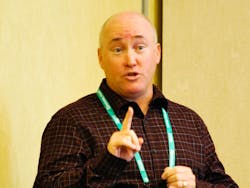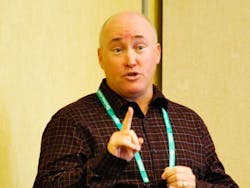Wireless solution saves millions for regulated energy company
TC Energy, with operations in the United States, Canada and Mexico, moves and holds natural gas in 57,900 miles of pipeline and more than 650 billion cubic feet of storage. The U.S. Pipeline & Hazardous Materials Safety Administration (PHMSA) code requires emergency shutdown (ESD) devices in two locations at each compressor station, which meant TC Energy needed a cost-effective solution to get in compliance because most of their compressor stations, built in the 1950s, had only one ESD pushbutton.
By using a WirelessHART mesh network, TC Energy was able to cost effectively add a second ESD and meet PHMSA requirements. Being the first in the industry to utilize a WirelessHART solution on its emergency shutdown system meant obtaining specific permissions from PHMSA, which required procedural documentation for the wireless application.
Ding by ding
According to PHMSA requirements, ESDs must be operable from at least two locations, each of which is outside the gas area of the station; near the exit gates, if the station is fenced, or near emergency exits, if not fenced; and not more than 500 feet from the limits of the station.
When the problem of not having enough ESD pushbuttons was dinged by PHMSA, Sloan’s mind went into action. “We only had one ESD in the gas area, and we needed two,” said Sloan. “Everyone’s fighting for money. We’re dealing with being strapped for capital.” Then—ding—the solution came to him. Columbia Gas Transmission had been acquired by TC Energy in 2016, and Sloan remembered that it had already been using wireless networks.
“When Brian thinks of stuff, he’ll call me, even if it’s in the middle of the night,” said Tony Simpkins, business development manager, North America, pervasive sensing, Emerson, who helped Sloan develop the wireless-mesh solution.
At TC Energy’s natural-gas compressor stations, a Rosemount 702 wireless discrete I/O transmitter was used, along with an Emerson Wireless 1410S2 Gateway and 781S Fieldlink Antenna, to initiate an emergency shutdown (ESD) system. “The antenna for the 702 is mounted on a pole so it doesn’t have to worry about any interference,” explained Scott Smith, senior sales representative, Rosemount Measurement, Emerson.
An Emerson SmartPower module and ESD pushbutton were also included. As the ESD system relied on a WirelessHART network, it was a significant change in traditional philosophy regarding safety control systems.
“WirelessHart is an open IEC 62591 standard introduced in 2007 and approved in 2010,” explained Simpkins. “It was developed by instrumentation companies for instrumentation. My favorite place to visit is the nuclear-sub base in Groton, Connecticut, which uses a mesh network. I was sure if it can pass there, we could pass. There are no IP addresses in the devices, so no one can hack your device. The IP address is in the gateway.”
Emerson’s WirelessHART network architecture can talk with multiple protocols, including EtherNet/IP, Modbus TCP, Modbus RTU, OPC, HART-IP, HTTP/S and with Emerson AMS, DeltaV and Ovation systems. It is a self-organizing, self-healing wireless mesh network with 99.9% data reliability, explained Simpkins. “We broke most best practices with this installation,” he said.
Devices that work together
Emerson’s WirelessHART products for industrial instrumentation operate on the self-organizing, self-healing mesh network that uses frequency hopping and is time-synchronized. Each device has long-range capabilities at up to 2,600 feet from device to device and long battery life guaranteed to 10 years at 1-minute updates.
“A lot of our competitors say they have a mesh network,” noted Simpkins. “In most cases, they have to tell devices to talk to each other. It’s impossible to manage all of those connection points. Ours does this intuitively. Secondary and tertiary connections start to form between devices that don’t have a direct view or connection to the gateway. As these devices are talking, they’re not only developing relationships with other devices, they’re developing a communication relationship. It learns about the reliability of connections. Devices are continually learning about their best paths.”
A device has a primary function to wake up, take a measurement and transmit it. It will take its measurement, send it and then go to sleep. Emerson devices on TC Energy’s WirelessHART mesh network can keep “one eye open” by using a low-power mode, so it can pass a measurement from a neighboring device that takes measurements at different intervals that are more frequent.
“We’ve got more than 230 compressor stations,” summarized Sloan. “We’ve started adding some devices to get back to those best practices. These stations aren’t very big. The farthest we had to mount something was about 700 feet. It took about a day or day and a half to equip each station.”
Underground cabling and conduit expense was eliminated by using wireless technology. Installation time was significantly reduced. Most importantly, fines for not meeting code were avoided.
TC Energy has saved around $1.5 million on emergency-shutdown devices with implementations of the solution on seven of its compressor stations. Twenty-one more stations have purchased equipment, and 26 additional stations have been scheduled for 2023. When the project is completed, the solution will be deployed on 54 compressor stations in the TC Energy pipeline and underground storage system. With an average savings of $200,000 per station, using the wireless technology will save TC Energy almost $11 million.
About the Author
Mike Bacidore
Control Design

Leaders relevant to this article:

